Closed Borders and Open Minds: Finding Adventure on the St. Croix
By: Ryan Polhemus // Photos by Chris Shane & Chris Bennett
"Hard tellin', not knowin'."
That frustrating little wink of Downeast wisdom, always uttered in the thickest of Maine accents, was the answer to most of our questions during three days on the St. Croix River in September 2020. How high is the water? How far to the next campsite? What's it like canoeing a border river when the border is closed? Sometimes the question was a joke, other times a challenge, but essentially it meant: "Why waste time asking? Go find out for yourself." So that's precisely what we did.
Six of us planned to navigate three canoes and one stand-up paddleboard from the river's source in Vanceboro roughly 35-miles to the hydroelectric dam at Kellyland. It's a remote but popular stretch of Class I and II rapids with no mandatory portages. Only a few of us had any real paddling experience, most of us had never met, and nobody knew a thing about this river. But in a year with so many canceled plans and curtailed freedoms, we wanted an attainable adventure to remind ourselves that the world was still out there waiting to be explored.

The St. Croix is less well-known than some of Maine's more famous waterways like the wild Penobscot and storied Allagash, but beloved by canoe guides and fly fishermen as a pristine hidden gem. Flowing southeast out of the Chiputnecook Lakes to Passamaquoddy Bay, the river carves roughly 70 miles of the border between the US and Canada-a border that had been closed indefinitely due to the Covid-19 pandemic. With a crossing station located right in Vanceboro, we would be paddling under the watchful eye of the Border Patrol the whole way. Not that we had anything to hide. But a few of us (including me) had limited whitewater experience, and setting foot on the wrong shore could land us a half-million dollar fine from the Mounties. I spoke to a US Customs and Border Protection agent while mapping out the trip and asked if we'd see her people out on the river. "You might not see us," she chuckled, "but we'll see you."
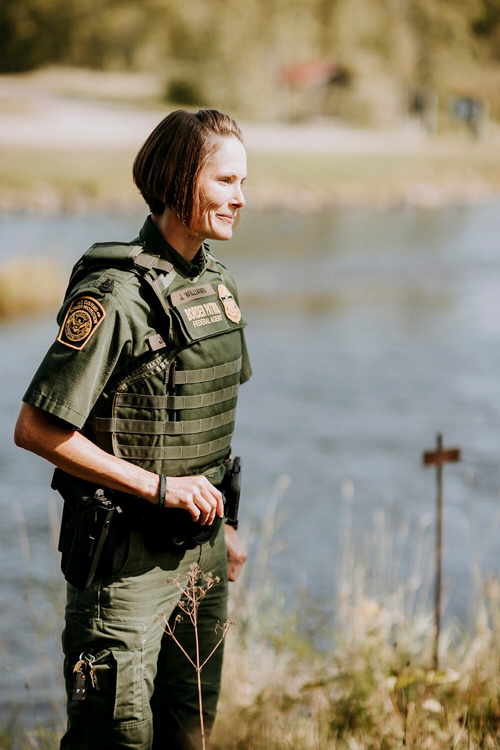
My journey began with a three hour drive from Boston to Portland to pick up the canoe I was responsible for borrowing, then four more hours to Vanceboro, watching the bars on my cell phone slowly disappear. A sign taped to the window of the only store in town read "Closed until the border opens," which meant two more hours in the car to find last-minute supplies. The group slowly trickled into the campsite as the sun set. Chris B., a photographer I'd adventured with before, arrived with me. Ashley, a kayak and SUP guide in Portland, had decided to make things more challenging by navigating the river on a stand up paddleboard-certainly a first on the rocky St. Croix. Next was Chris S., another photographer documenting our adventure. Walker arrived with the camp kitchen and most of the groceries. A former whitewater guide and videographer, he was the most experienced river rat among us, and he unloaded his canoe and an astonishing amount of gear.
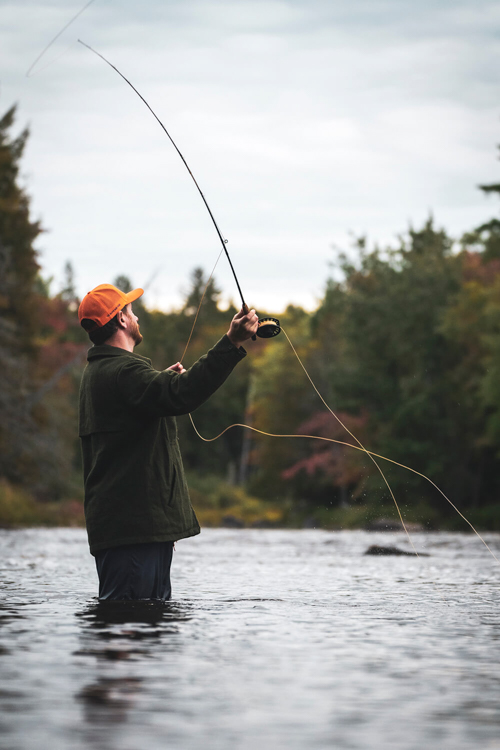
The campsite was right on the river, just downstream from a big train trestle that straddled the border, with no more than 100 feet separating us from the Canadian side. "Everyone bring their comfy chair?" Walker asked in an exaggerated Maine accent as he unfolded his small throne by the fire. The group was mostly backpackers, with ultralight gear that favored efficiency over luxury, and we marveled at his cast iron skillets and creature comforts. Clearly we had important lessons to learn about canoe camping.
The rest of us perched on upturned logs and ate beef stew while the stars came out, talking excitedly about the days ahead. There's no better way to get acquainted with fellow travelers than sharing a campfire. The conversation meandered like the river babbling behind us, and everyone added a little of their lore. Ashley taught us the names of tiny constellations, jumping with her finger between stars across the Milky Way to show us Arcturus, Aquila, and Delphinus the kite. A freight train rumbled across the bridge, rattling the coals in the fire, and Chris B. shared the locomotive knowledge he inherited from his father as it hooted and groaned into the night. We all turned in early, anxious to begin our adventure. The final member of our crew, Sadye, arrived in the wee hours. She'd put her kids to bed, packed her gear, and made the four hour drive from Portland in the dark. A former guide and absolute champion, she'd be paddling the first 12 miles of the route in the bow of my boat on less than an hour of sleep.
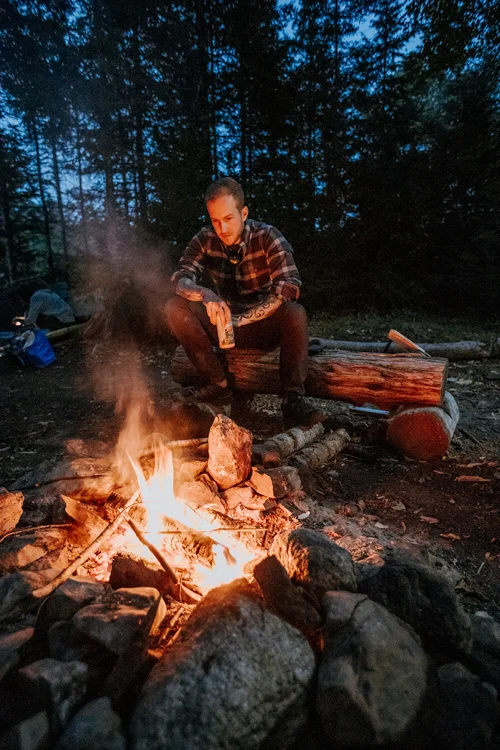
The sunrise was obscured by smoke from forest fires thousands of miles away. We packed up slowly in the eerie glow, weighing and balancing our mountain of gear between the three canoes. We pushed off into the shallow river as the sky cleared and steered downstream. The water was as warm as a bath just below the dam, which made me feel better about the prospect of ending up in it if the rapids got the better of me. A bald eagle saw us off, wheeling back and forth across the border as we were carried off by the current.
After less than a mile the scattered homes of Vanceboro disappeared and the river's remoteness began to take shape around us. A canyon wall of trees rose high on each side of our little convoy, casting long shadows on the water. It was already difficult to keep in mind that the left bank was off-limits-lines on a map seem silly when you're sitting on them. But all our questions about the meaning of international borders disappeared after another mile, when we hit Wingdam Rips. Our first rapid was just a quick Class I, but there's nothing like paddling whitewater to snap you out of a daydreams and thrust you violently into the moment. Sadye and I ricocheted off a few rocks but came through mostly dry, and turned to watch everyone else send their first rip. We all clapped when Ashley came through on her board, waving her paddle triumphantly in the air.
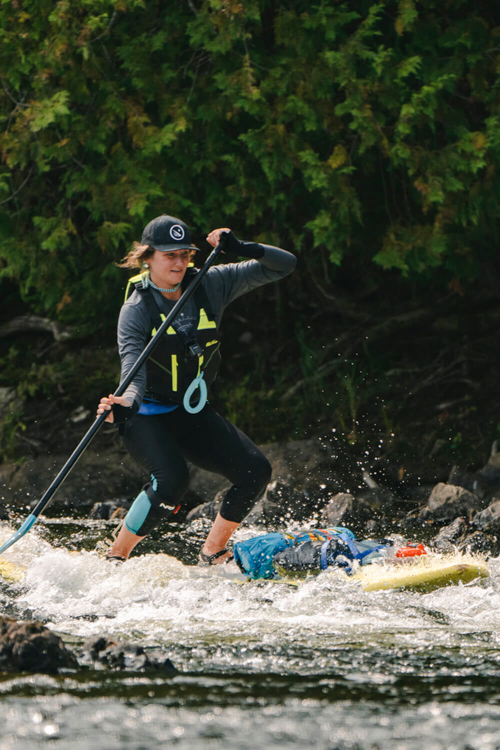
The first day was all about finding the rhythm of the river. After a marathon of quick Class I's and II's, the current slowed below Mile Rips, running broad and deep through a maze of meandering coves. We alternated battling and benefitting from the wind, drifting on the calm sections to snack and spot eagles' nests. Three our four serpentine twists later, it was hard to tell if the land off the bow was American or Canadian.
We heard Little Falls growling in the distance before we saw it, the only Class III rapid on our route. We pulled off to survey the drop, shouting about the best line over the roar of the water. The river split around a small island at the top of the rapid, then narrowed between twin granite walls, cascading in white plumes over boulders and ledges scraped away by ancient glaciers. It looked menacing, but nobody opted for the portage. The low water was a mixed blessing here-it meant more rocks to contend with, but it also lowered the stakes for getting pinned against one. We whooped and yelled on our way down like a bunch of kids in a playground. Navigating a big rapid successfully will make you feel like a pro, even if you made it through on sheer luck.
After six or seven miles steering through craggy rapids we were exhausted, but it was still early, and we decided to leave the tempting campsite at Little Falls behind to make more miles on our first day. Just when I felt like I was getting the hang of this whitewater thing, my hand began to cramp around the paddle, and a bad decision at Cedar Island Rips nearly put us in the water. I was relieved when we pulled into camp at Scotts Brook. After 12 miles on the river we were all thinking about a nap. Sadye quickly pitched her tent to catch up on lost sleep, and a member of the group who shall remain nameless had one beer and passed out next to the fire.
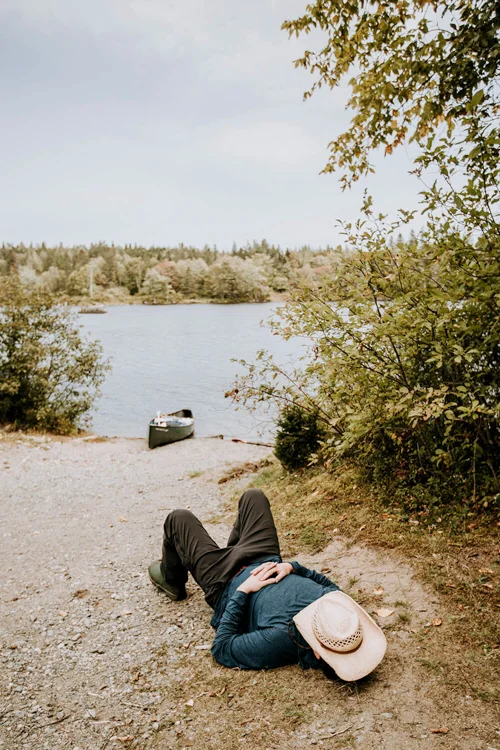
Canoe trips combine the luxury of car-camping with the remoteness of lightweight backpacking. We hadn't seen a soul on the river all day and there was no light or distant traffic noise to spoil the wilderness, but we weren't relegated to dehydrated meals and filtered river water. We felt like lords of the frontier, feasting on grilled steaks and a cooler full of beer by a crackling fire. We rehashed the day, and recalled the parts of our lives we'd lost to the pandemic. Chris B. had been in the middle of a cross-country bike ride when he'd been forced off the road because he could no longer resupply. I'd scrapped a monthlong trip around South America I'd been planning for nearly year. Ashley, who spent winters making snow at Sunday River and summers guiding kayak and paddleboard trips out of Portland, had seen both her seasons affected. Sadye had been forced to take on the role of teacher in addition to her real job. She had been homeschooling her kids, opting for practical rather than academic courses, like "how to change a tire."
We were all grateful to be out here, away from the chaos of forest fires, politics, and the pandemic to spend a few days getting reacquainted with our sense of wonder. The sound of rushing water lulled me quickly to sleep. I relived the rapids in my dreams, feeling the bump and sway of the boat as if I were still on the river dodging rocks and pivoting around pillows, excited to be better tomorrow.
The trees whispered us awake to another hazy sunrise. The forecast called for 15mph winds blowing against us with gusts up to 30. With miles of open water waiting for us downstream, it was going to be a long day.
Sadye was well-rested after 12 hours of hard sleep, which proved important because the river put us right back into quick, bony water. She shouted out hazards as she saw them and picked our lines while I was busy in the stern learning the valuable lesson that, when steering a canoe, it's important to look where you want to go, not at the rocks you're trying to avoid. We also learned that it's hard to spot shoals in a headwind, and with the river so dry we hit a number of them. Watching Chris and Chris tow their boat across shallow stretches from a distance looked as if they were walking on the surface.
The history of the St. Croix ran deeper than the water, and the river was lined with relics. The current slackened in grassy marshes, where thousands of old pulp logs paved the riverbed, castaways from the enormous log drives of centuries past. Many of the rapids and campsites along the river were named by loggers-Pork Rips, where a barrel of salt pork was lost. Baby's Grave, where an infant's body was found and buried. The skeletons of old wooden fish weirs reminded us that before the settlers and logmen, this was the territory of the Passamaquoddy people, who followed enormous salmon runs upstream in the spring and hunted along the banks. Other objects we saw were newer and more dissonant: an ancient truck bed rusted on the right bank, and every so often a sunken beer can glinted its national pride from beneath the surface-Labatt from the Canadian paddlers, Bud Lite from the Americans.
The first half of the day tested our endurance. The rips above Loon Bay felt like paddling through a graveyard. We jostled our boats through narrow channels between boulders that protruded like headstones from water only half a paddle deep. The rocks in the water were streaked with paint, and we added a bit of our own. Between the rapids, the wind picked up and forced us to paddle hard. Ashley had lost her fins on the rocks, and was being battered by the wind. Sadye and I towed her through the flat sections so she didn't fall behind.
There were no loons on Loon Bay, just miles of choppy water blowing us in the wrong direction. We stopped for lunch at a boat launch and laid in the sun, hoping to wait out the wind. Small signs of civilization peeked from between the trees; the shore was studded with ramshackle river cabins, and across the water on the Canadian side stood a couple of grand lodges. With few exceptions, the campsites and amenities on the opposite shore had looked better-managed, with huge stacks of firewood and enviable light. We grumbled about the unfairness of it over a much-needed pot of coffee. Five more miles of windy paddling lay between us and our day's destination.
But the grumbling ceased once we reached shelter beyond the bay. The river narrowed again into serrated granite, and we hit the trip's biggest drop at Dog Falls, a thrilling nosedive into churning white foam. After that, the current became drowsy as we neared the Annapurna campsite. The water was deep and oily, and our paddles gulped through the last easy miles while the light turned to gold on the trees.
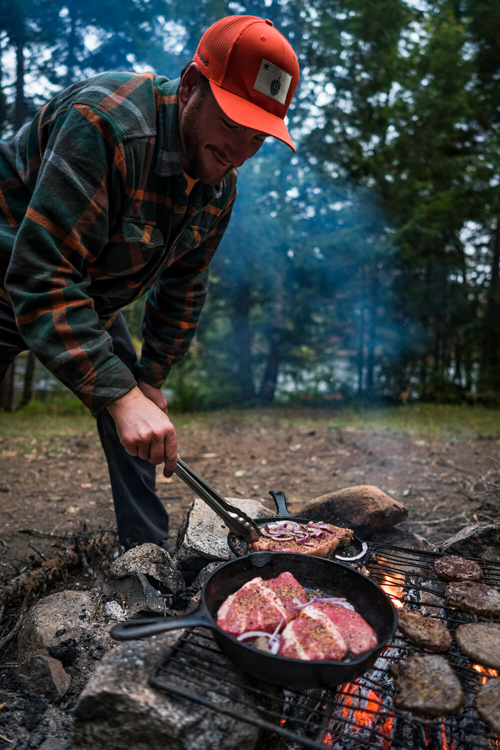
It was a perfect campsite, jutting proudly into a bend in the river overlooking swaying fields of high grass which where we hoped to see moose grazing. Beyond the stellar view, the site's finest amenity was a makeshift bar constructed from sticks and old timber. We didn't hesitate to take advantage of it. After a well-deserved beer, Walker and Ashley broke out their fly rods while I snuck a quick bath between the canoes. Twenty miles of cold streams emptying into the river had made the water bracingly cold, but it felt good to rinse away the toil of two hard days. After dinner, a bag of Werther's originals was passed around the fire, and we discovered the best way to fake a Maine accent is to pop one in your mouth and talk around it.
The canoes sat higher in the water on our final morning, six large meals lighter, and we packed quickly for our final push to the Grand Falls Flowage above the dam. There was urgency in today's paddling, with high wind in the forecast and heavy rain coming after noon.
All the real rips were behind us, and we set out in soft black water that carved deep through feathery marshland. The foliage near the water was brushed with crimson, as if the forest were beginning to rust. Just a few days on the river and I had already begun to notice changes in its character. Calm, contemplative miles were were cut short by quick angry torrents, as if the water were arguing with itself. Our phones began to squawk and stir as we neared the lake, jumping between Canadian and American time. Each shore looked identical, but they remained an hour and an entire world apart.
We stopped for lunch at an unmarked campsite we informally dubbed "Oh Crap We Can't Make It Across The Lake Today," then gritted our teeth for the final push, racing dark clouds across the roiling water. They were the trip's hardest and least rewarding miles, back toward our cars, our lives, and the limitations we'd been out here to escape.
Our cars were waiting for us above the Kellyland dam. We'd paid the owners of the Vanceboro campsite to shuttle them here while we paddled, an expense whose value cannot be overstated after three days on the river. As we divided up the gear and strapped down the boats, we all agreed we needed to do this again soon. When would the next trip be? Hard tellin', not knowin'.
Ryan Polhemus is a travel and adventure writer based in New England. He believes firmly in the power of short stories, long hikes, and black coffee, and only wakes up early for powder days and passport stamps. Website: www.ryanpolhemus.com Instagram: @residual_ink Twitter: @residual_ink






